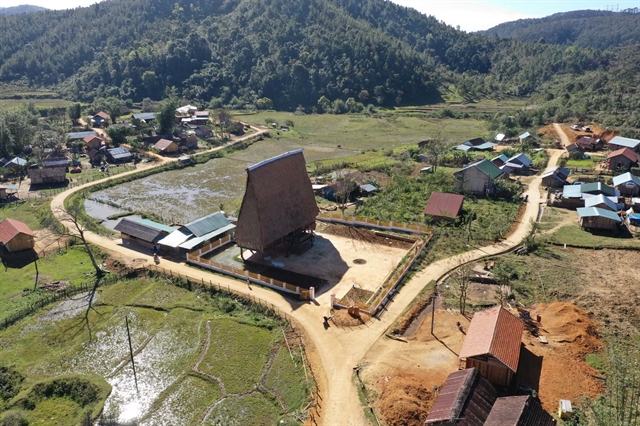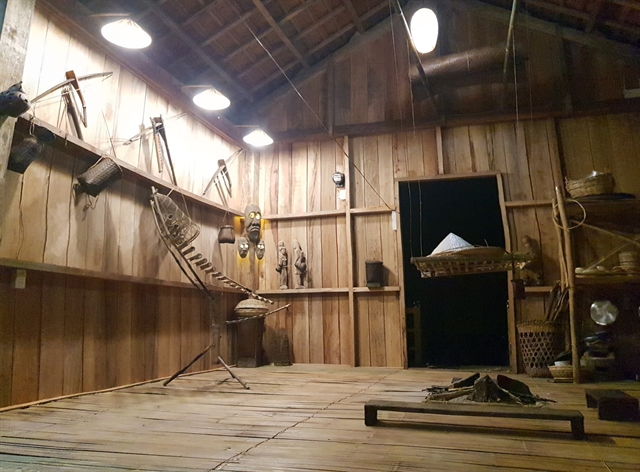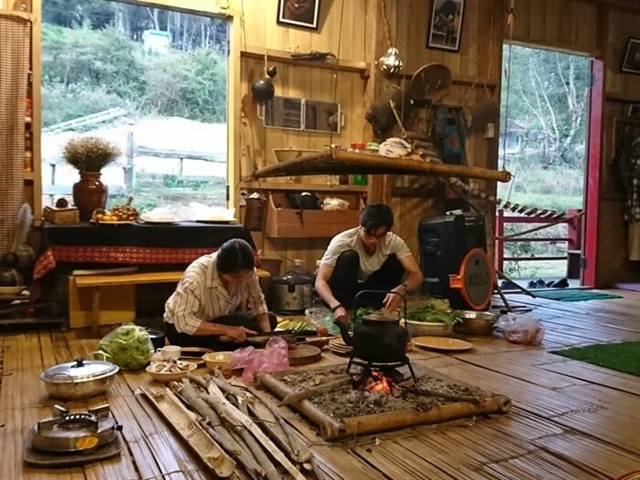Kon Pring is a picturesque community-based tourism village surrounded by a valley of thousands of tall green pines. It is likened to a second Đà Lạt in the Central Highlands because of its cool climate year-round.

Kon Pring village is surrounded by a valley with thousands of green pines. — Photo sgtravel.vn
By Lâm Giang
Kon Pring is a picturesque community-based tourism village surrounded by a valley of thousands of tall green pines. It is likened to a second Đà Lạt in the Central Highlands because of its cool climate year-round .
Located on Măng Đen plateau, Kon Pring village belongs to Đắk Long Commune, Kon Plong District, Kon Tum Province. This is one of four community cultural tourism villages in the district located along Highway 24, 3km east of the district centre. The Mơ Nâm people (a branch of the Xê Đăng ethnic group) make up 95 per cent of the population in this village.
We went to the village on a weekend afternoon. Fortunately, we managed to make the trip before the fourth wave of the COVID-19 pandemic hit the country in late April.
From Măng Đen Town, we went along Highway 24 to the crossroads, turning right to the village.
Looking down from the pine hill along Highway 24, Kon Pring stands out with the sky-high roof of its communal house poking out of the middle of the green forest. Surrounding the communal house are small beautiful stilt houses lined up one after another. Many small streams flow through the village connecting the surrounding mountainous terrain and pine forest.
In the blue smoke mingled with the clouds of Kon Pring mountain, graceful girls washed clothes by the water wells, children chattered on the grass at the top of the village, and families gathered around in their kitchens. It was very simple but very enchanting.

The furniture inside a homestay in Kon Pring village. — Photo thanhnien.vn
We were attracted by the architecture of the communal house, which is built in a traditional style from simple materials such as wood and bamboo. This is a special kind of house on stilts belonging to the ethnic minorities of the Central Highlands. The roof of the communal house towers above the village. Viewed from afar, the roof looks like the blade of an axe standing upright and proud in the middle of the village.
According to the people here, the communal house must be built high enough to reach the sky like that in order to gather the sacred air of heaven and earth. In this way, it connects people, the universe and the gods. Moreover, the communal house is the community house Kon Pring villagers used to welcome guests, organise festivals, meetings and annual traditional festivals.
According to the elderly villagers, in the traditional society of the Mơ Nâm people in Kon Pring, families are typically large and live with three or four generations under one roof. Now, however, they live together in smaller family units. Most of the people here follow a bi-generational system, leaning towards patriarchy. A matriarchal household is very rare. Customary and abstinence laws are prescribed by the community to deal with guilty parties.
Daily meals are simple but wine is a traditional drink that preserves the local identity of the people and helps them to connect with the other Central Highlands ethnic groups through exchange and shared community activities.

Typical space inside a homestay in Kon Pring village. — Photo thanhnien.vn
The festivals of the people here take place all year round including the sowing ceremony, new rice ceremony and communal house festival.
In particular, locals still retain their traditions with special cultural activities in the village such as gongs and xoang dance.
We quickly integrated into daily life with the villagers and had the opportunity to experience cooking with the locals and enjoyed the delicious rượu cần (wine stored in a big jar and drunk with long bamboo straws).
For our meal, we enjoyed “Mắm Giố”, a culinary speciality of the Mơ Nâm people. It is similar to the sour sauce of the Kinh people. It is made mainly from pork or buffalo meat, or sometimes crab and fish. If Mắm Giố is made from buffalo or pig meat, it will take about a month to prepare, if it is made from stream fish it takes about half a month, and if it is made from crab it takes about one week. When ready to eat, Mắm Giố is cooked again to eat with rice. It can also be cooked with soup with wild vegetables.
In the evening, we have a campfire and are immersed with the villagers in the gong dance which is extremely vibrant and exciting. This is one of the long-standing cultural beauties that Kon Bring villagers still keep until this day.

Coming to Kon Pring, visitors have the opportunity to experience cooking with the locals. — Photo luhanhvietnam.com.vn
According to a local, the sound of gongs is the soul of the Mơ Nâm people, because its sound blends the human soul with the immense mountains and forests. Therefore, no matter how modern it is, the Mơ Nâm people here still keep playing their gong.
The more we listened and immersed ourselves in the gong dance with the people, the more we felt the magic of the gong the more infatuated and seduced we became by its melodies.
“Everything here is so beautiful. It is very similar to my expectations. Villagers are very warm and friendly. I really like it and hope to come here again,” said tourist Nguyễn Thị Ngọc Dung from HCM City.
With a cool climate year-round, Kon Pring is an ideal destination for travellers who want to rest, enjoy and experience the culture as well as explore the depths of the people and the land of Kon Tum. VNS

Unique cuisine of the Mơ Nâm people in Kon Pring village. — Photo luhanhvietnam.com.vn